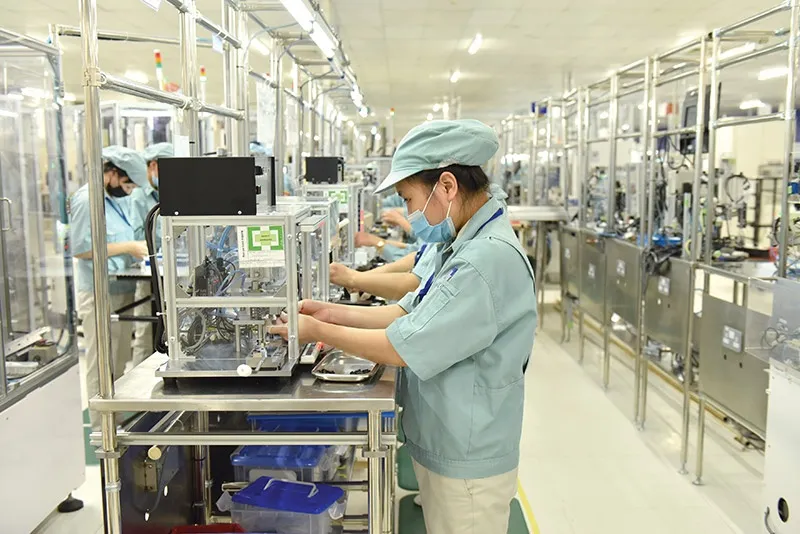
The General Statistics Office last week reported that in April, Vietnam’s index for industrial production (IIP) increased 9.4 per cent on-year “thanks to good control of COVID-19 and enterprises taking the bigger initiative in labourers and business and production plans for expansion,” in which the manufacturing and processing sector creating 80 per cent of industrial growth expanded 11.3 per cent on-year. In the first four months of this year, the IIP increased 7.5 per cent on-year, as the manufacturing and processing sector expanded 8.3 per cent on-year.
Growing production has resulted in rising demand for electricity and fuel. The Ministry of Planning and Investment reported that the economy’s production and distribution of electricity in April increased 2.8 per cent on-year. In the first four months, the rate increased 6.6 per cent against the same period last year, when it decreased 6.5 per cent on-year.
State-run Electricity of Vietnam (EVN) reported that all of its activities were increasing on-year in the first quarter of 2022. Specifically, its gross output of industry is estimated to be VND88.83 trillion ($3.86 billion), up 7.15 per cent, while the produced and purchased electricity volume is nearly 60 million kilowatt-hours, up 7.4 per cent; and commercial electricity totalled nearly 54.47 million kWh, up 7.15 per cent. Electricity for agro-forestry-fishery climbed 7.73 per cent, while the rate is 3.34 per cent for construction and industrial activities, 13.6 per cent for households, and 1.55 per cent for trade and hotels. EVN’s total revenue from electricity sales is about over VND101.41 trillion ($4.4 billion), up 9.26 per cent on-year.
Meanwhile, state-owned PetroVietnam reported that its total revenue in Q1 2022 is estimated to be over VND158 trillion ($6.87 billion), up 32 per cent on-year. The group exploited 2.85 million tonnes of crude oil, up 5 per cent on-year, and produced 457,700 tonnes of nitrate, up 11 per cent. The group’s export turnover totalled $792 million, up 71 per cent.
The General Statistics Office (GSO) said that in the first four months, enterprises’ confidence has been growing since last October when the government applied a flexible pandemic policy, making it easier for businesses to perform.
Having operated in Hanoi for 13 years, Japanese-funded Alphan Industries has been manufacturing spare parts for vehicles and had to halt material imports from Japan and a number of foreign markets for a few months last year. Production resumed as quickly as possible and has gradually amplified an increase in exports.
A company representative said that in the first four months of 2022, the business’ industrial gross output climbed 8 per cent as compared to the 6 per cent rise in the corresponding period last year, while the import turnover expanded by nearly 9 per cent per cent since October 2021. “The firm is working to expand export markets to Europe, the United States, and Africa,” he said.
Located not far from Alphan Industries is Japan’s Kaya Industry Co., Ltd., churning out cutlery and hand tools which are sold in Vietnam and exported to Japan.
Since early this year, the enterprise has been recruiting workers in its plan to expand production and witnessing a rise of about 8 per cent in import turnover of materials used for its production.
“It is expected that the 4-month revenue of the company increased about 7 per cent on-year, as compared to a 5 per cent climb in the same period last year,” said Nguyen Anh Mau, head of sales at Kaya Industry. “The company’s leadership has set a target of 10 per cent in revenue expansion this year, with export turnover swelling by 11 per cent.”
Takeo Nakajima, chief representative of the Japan External Trade Organization (JETRO) in Hanoi cited a recent JETRO survey as stating that 55 per cent of Japanese companies in Vietnam answered that they would “expand” their business in Vietnam in the next 1-2 years, the highest number in ASEAN. The rate of Japanese with the answer of “Shrink/withdraw” their business in Vietnam is only 2 per cent. Those who said “expand” hope for the recovery of overseas markets. About 71 per cent of the respondents pointed that “sales increase in the export markets” is the driver for expansion.
“Vietnam welcomes the investment of foreign companies, and they can enjoy low tariffs on import and export - a very favourable investment environment for foreign enterprises,” Nakajima said.
GSO figures showed that in the first four months, the Vietnamese economy’s total export-import turnover is estimated to stand at $216 billion, including $116 billion from exports, up 25 per cent on-year; and $110 billion from imports, up 27 per cent on-year.




















